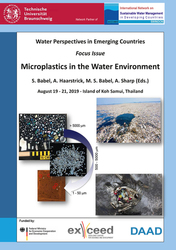| Departments | |
|---|---|
| Book Series (96) |
1378
|
| Nachhaltigkeit |
3
|
| Gesundheitswesen |
1
|
| Humanities |
2364
|
| Natural Sciences |
5406
|
| Mathematics | 229 |
| Informatics | 319 |
| Physics | 980 |
| Chemistry | 1363 |
| Geosciences | 131 |
| Human medicine | 243 |
| Stomatology | 10 |
| Veterinary medicine | 108 |
| Pharmacy | 147 |
| Biology | 835 |
| Biochemistry, molecular biology, gene technology | 121 |
| Biophysics | 25 |
| Domestic and nutritional science | 45 |
| Agricultural science | 1004 |
| Forest science | 201 |
| Horticultural science | 20 |
| Environmental research, ecology and landscape conservation | 148 |
| Engineering |
1792
|
| Common |
98
|
|
Leitlinien Unfallchirurgie
5. Auflage bestellen |
|
Advanced Search
Water Perspectives in Emerging Countries (English shop)
Microplastics in the Water Environment. August 19 - 21, 2019 - Island of Koh Samui, Thailand
Müfit Bahadir (Editor)Preview
Extract, PDF (1 MB)
Table of Contents, PDF (600 KB)
Today, plastic materials are present in nearly all spheres of modern life, starting from simple packaging, clothes containing synthetic fibers, containers, drinking bottles and tires to various life-supporting medical equipment. Their manufacture, use and discharge have significantly increased the amount of plastic waste, including plastic marine litter in oceans, which is detrimental to the ecosystems and human health. Marine litter and microplastics are having a great impact on global environment and human health. How to improve reuse and recycling, to minimize plastic waste and to promote plastic alternatives, have received much attention recently for the purpose of controlling plastic litter in the freshwater and marine ecosystems.
Research related to microplastics is at its infant stage and thus is facing a number of unknowns and incompletely answered questions. Most of known literature studies are concentrated in the Northern hemisphere (Europe, North America, etc.), but very few studies are known in the Southern hemisphere, for example Asia or Africa. In addition, most of the investigations were carried out in marine ecosystems; however, the main source of microplastics pollution actually originates from terrestrial and freshwater ecosystems. Until today, no reliable inventory of microplastics pollution of rivers, estuaries, and sediments has been carried out in order to assess the current state and subsequent health risks to human and other living organism.
The objectives of this book is to provide readers with state-of-the-art knowledge of MP pollution and its related implications, and to identify and to deliberate upon the research needs and concepts against the background of increasing threats to ecosystems, wildlife and human health.
| ISBN-13 (Hard Copy) | 9783736970892 |
| ISBN-13 (eBook) | 9783736960893 |
| Final Book Format | B5 |
| Language | English |
| Page Number | 138 |
| Lamination of Cover | matt |
| Edition | 1. |
| Publication Place | Göttingen |
| Publication Date | 2019-10-24 |
| General Categorization | Non-Fiction |
| Departments |
Agricultural science
|
| Keywords | Microplastics, sources, freshwater pollution, marine debris, plastic waste, Pelagic microplastics, standardization/harmonization, field surveys and prediction, Citarum River, microplastics, occurrence, sediment, upstream downstream, water |








